Kelly Chorpening & Peter Morrens: Graphic Longing
Kelly Chorpening (an artist living in London) and Peter Morrens (an artist living in Lier, Belgium) met this past April for the first time. They have been collaborating since- mostly via email and post.A record of their dialogue thus far has been published in the inaugural issue of TH INK, a Belgian cahier dedicated to contemporary drawing. A copy is enclosed. For INTERRUPTED CORRESPONDENCE Kelly and Peter would like to further their collaboration by creating work— together for the first time— over the course of a day, using as inspiration the dialogue from TH INK (that compressed the time in which it took place) and the wall of images we created (the visual debris shared throughout the exchange). A colour image of the wall is enclosed. The range of artists, ideas and approaches that has been covered is vast, and provides rich ground for making a collaborative piece; for continuing the correspondence.
The piece would begin by drawing a line across the wall image, and seeing what different associations, contrasts and possible narratives this simple act would create. Responses could vary considerably, from drawing, painting, photography, film, written and spoken word, and performance. The process would be documented, and would result in a new wall that evidenced the shared activity of the day.
Kelly Chorpening (an artist living in London) and Peter Morrens (an artist living in Lier, Belgium) met this past April for the first time. They have been collaborating since- mostly via email and post.A record of their dialogue thus far has been published in the inaugural issue of TH INK, a Belgian cahier dedicated to contemporary drawing. A copy is enclosed. For INTERRUPTED CORRESPONDENCE Kelly and Peter would like to further their collaboration by creating work— together for the first time— over the course of a day, using as inspiration the dialogue from TH INK (that compressed the time in which it took place) and the wall of images we created (the visual debris shared throughout the exchange). A colour image of the wall is enclosed. The range of artists, ideas and approaches that has been covered is vast, and provides rich ground for making a collaborative piece; for continuing the correspondence.
The piece would begin by drawing a line across the wall image, and seeing what different associations, contrasts and possible narratives this simple act would create. Responses could vary considerably, from drawing, painting, photography, film, written and spoken word, and performance. The process would be documented, and would result in a new wall that evidenced the shared activity of the day.
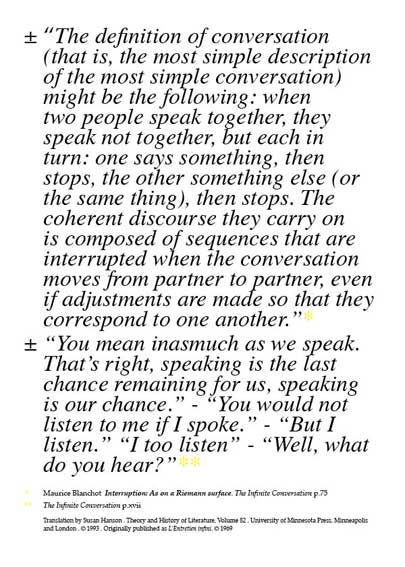




Neil Ferguson: Temporary Almost Nothings.
The work would consist of 16 x 12 inch drawn linear chalk circles8 would be drawn outside and 4 inside the gallery space. The circles will be drawn both inside and outside of the gallery space.The aim is to consider the differences how almost nothings correspond to, through and across space and boundaries. The work becomes sited as thought.Varying forms of correspondence and interruption can take place between the two sets of drawings and the surroundings and therefore add differing interpretation to the drawn circle. The work aims to consider how these connections effect the spectator’s reading of the works in the immediate environment internally and externally. In effect the spectator becomes the actor of the artwork through their engagement with noticing and moving. Drawn circles define their own internal space The drawing and placing of the circles, as opposed to them not being drawn or placed, attempts to heighten the spectator/viewer/passer-by’s awareness of their immediate space and their relationship with that space.The drawn circles define a space and place for consideration. The circles aim to engage and intrigue but not dictate to people.People and spectators can decipher their own messages and enter dialogue appropriate to their own context of interest or disinterest. The circles can be social or anti-social, choice is offered.Placing circles or objects both outside and inside an art space is not a new debate. However it is deliberately being employed at a time when the art market and art education again addresses “financial crisis”. For again neither the art market, nor notions of “the contemporary” variously promoted through art education seems able to engage or accommodate a wider public engagement without money, grants or patronage of some sort. If this is the case then focus returns to maker’s opportunity to influence how “arting” takes place. Temporary Almost Nothings make demands in the belief that they offer correspondence.Differing correspondence forms opinion, opinion structures critique, critique influences action, action requires discussion to influence.The materials. Chalk on pavement and gallery floor. Colour of chalk line to be determined by surroundings and colour/texture of floor. Placing the circles: The circles would be placed in relation to: a. the width of the pavement and entry to Project Space and b. the shape of the gallery and how other works occupy floor space.The circles need to correspond/vice versa. How they correspond or not becomes the artwork for those who choose to “notice” or not. As the drawings are chalk and therefore temporary in relation to both weather and being walked on I would propose refreshing the works during my involvement in any event. I do not view this as being in conflict with the notion of them being temporary, but rather a confirmation of their “almost nothingness and temporality” in that they can and need to be refreshed in relation to events taking place around them. Their appearance and disappearance is the strength of their “almost nothingness”, adjusting to changes taking place in the street and gallery, to be temporary, but not going away easily.The circles should never be permanent. They should disappear and reappear though peoples stories as history. Timing: Ideally I would like to set up a system where the circles would be around as long as they retained a role within the event. However I appreciate that might not be possible or make sense within the strategies you employ in presenting events. For example I would be happy to refresh the circles every Friday throughout the event at 2.00pm but this could easily be adapted to be presented as a shorter event where the circles could just be made and left to be temporary My experience of drawing the circles outside is that it takes a few days for any viewer to alter “their” sense of the circles. So I would suggest them being around, refreshed, added to, for a minimum of 3-5 days, however I am happy to discuss whatever fits the event calendar best. There is a large difference in them being seen or noticed that I am happy to debate, but happy to work with.
The work would consist of 16 x 12 inch drawn linear chalk circles8 would be drawn outside and 4 inside the gallery space. The circles will be drawn both inside and outside of the gallery space.The aim is to consider the differences how almost nothings correspond to, through and across space and boundaries. The work becomes sited as thought.Varying forms of correspondence and interruption can take place between the two sets of drawings and the surroundings and therefore add differing interpretation to the drawn circle. The work aims to consider how these connections effect the spectator’s reading of the works in the immediate environment internally and externally. In effect the spectator becomes the actor of the artwork through their engagement with noticing and moving. Drawn circles define their own internal space The drawing and placing of the circles, as opposed to them not being drawn or placed, attempts to heighten the spectator/viewer/passer-by’s awareness of their immediate space and their relationship with that space.The drawn circles define a space and place for consideration. The circles aim to engage and intrigue but not dictate to people.People and spectators can decipher their own messages and enter dialogue appropriate to their own context of interest or disinterest. The circles can be social or anti-social, choice is offered.Placing circles or objects both outside and inside an art space is not a new debate. However it is deliberately being employed at a time when the art market and art education again addresses “financial crisis”. For again neither the art market, nor notions of “the contemporary” variously promoted through art education seems able to engage or accommodate a wider public engagement without money, grants or patronage of some sort. If this is the case then focus returns to maker’s opportunity to influence how “arting” takes place. Temporary Almost Nothings make demands in the belief that they offer correspondence.Differing correspondence forms opinion, opinion structures critique, critique influences action, action requires discussion to influence.The materials. Chalk on pavement and gallery floor. Colour of chalk line to be determined by surroundings and colour/texture of floor. Placing the circles: The circles would be placed in relation to: a. the width of the pavement and entry to Project Space and b. the shape of the gallery and how other works occupy floor space.The circles need to correspond/vice versa. How they correspond or not becomes the artwork for those who choose to “notice” or not. As the drawings are chalk and therefore temporary in relation to both weather and being walked on I would propose refreshing the works during my involvement in any event. I do not view this as being in conflict with the notion of them being temporary, but rather a confirmation of their “almost nothingness and temporality” in that they can and need to be refreshed in relation to events taking place around them. Their appearance and disappearance is the strength of their “almost nothingness”, adjusting to changes taking place in the street and gallery, to be temporary, but not going away easily.The circles should never be permanent. They should disappear and reappear though peoples stories as history. Timing: Ideally I would like to set up a system where the circles would be around as long as they retained a role within the event. However I appreciate that might not be possible or make sense within the strategies you employ in presenting events. For example I would be happy to refresh the circles every Friday throughout the event at 2.00pm but this could easily be adapted to be presented as a shorter event where the circles could just be made and left to be temporary My experience of drawing the circles outside is that it takes a few days for any viewer to alter “their” sense of the circles. So I would suggest them being around, refreshed, added to, for a minimum of 3-5 days, however I am happy to discuss whatever fits the event calendar best. There is a large difference in them being seen or noticed that I am happy to debate, but happy to work with.
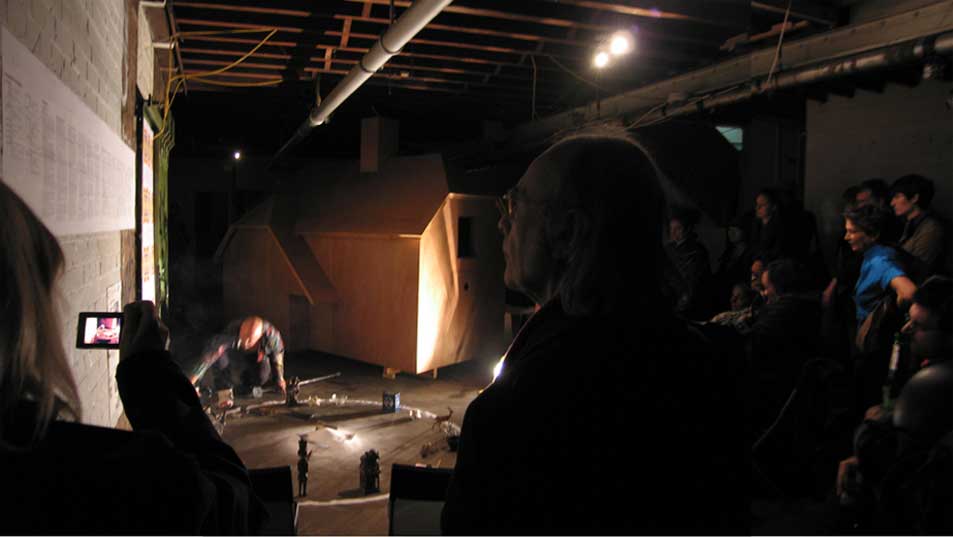
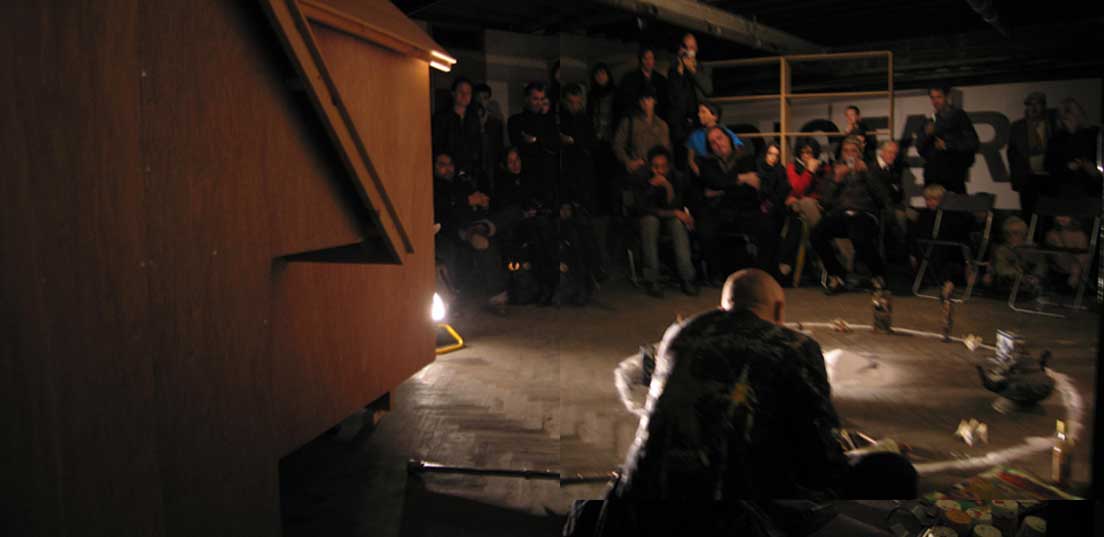
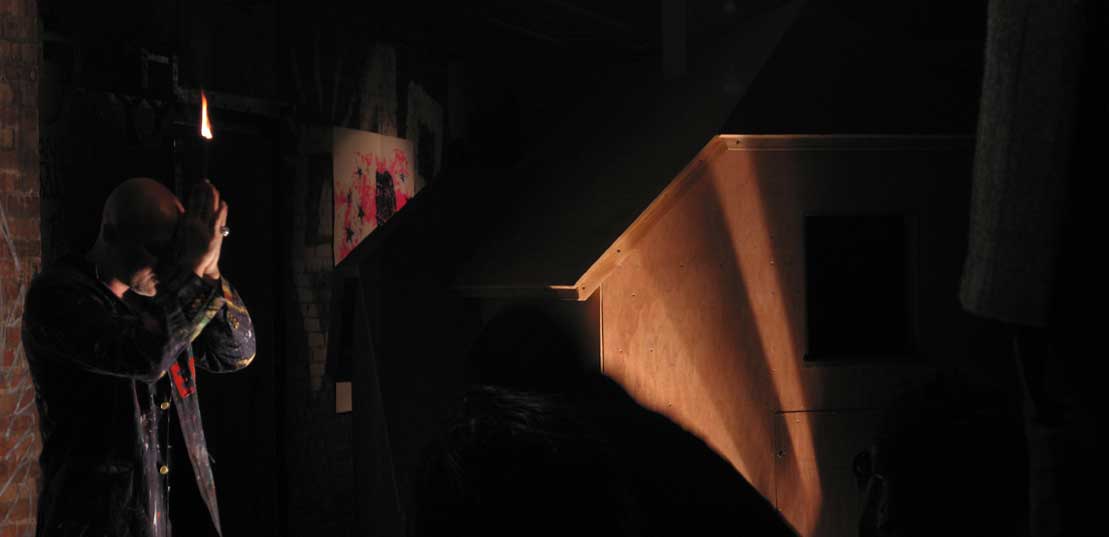
Paul Sakoilsky & Nazarin Montag: Mother Hysteria≠: A Dialogue with the Dead
(A performance/installation) In May 2006, I carried out the action, ‘Hysterianyu (Mother Hysteria)’, for camera in public; Szlmpla-Kert bar, in Budapest. For this, the first and last time, I dressed in drag, I donned a psychedelic dress of my deceased mother, and carried out a suicide routine. (The video, shot by Sebastian Hüber, cab be seen online here: http://www.youtube.com/watch?v=qXRM_yRZeKM . The Hungarian Art Journal Balkon (issue 2006/7.8/ covered the event as a six page feature: ‘Hisztérianyu/mother hysteria: Paul Sakoilsky akciója’ “A Szimpla-kertben jöttek a szellemek, és evlvitték az esemetmet” (Trans. ‘At Szimpla-Kert the ghosts came and stole my mind’), in Hungary’s main art journal, Balkon issue: 2006/7.8. [Can eb viewed online here: http://www.balkon.hu/2006/2006_7_8/13hiszteria.html http://www.balkon.hu/2006/2006_7_8/14adamik.html ] For ‘MH≠2: Dialogue with the Dead ‘ - The idea for this action/installation came into direct consideration of the FIVE YEAR’s thematic, and the Blanchot quotes. A wall-based installation, consisting of wallpapered photographs [Cf. Attached Jpg. Nazarin Montag - here only as an example] will be housed in the recessed, brick-up doorway next to the graffitied face; this will form an Integral backdrop/element of the overall installation. In front of this we will construct a magic circle, six feet in diameter, drawn out with salt and other materials. This will also contain small altars composed of Sakoilsky’s mother’s broken object d’art/curios, a carved table and chair or stall. For a period of an hour, Sakoilsky, dressed in his mother’s kaftan, etc. will sit in the circle, meditating and ‘dialoguing’ with his mother/the dead, whilst drawing/writing (re. spirit writing) in a journal or on loose sheaves of paper - and carry out other, extemporised, quiet actions. Whilst the audience, will not be encouraged to speak with the performer – some interaction may inevitably occur. Also, although, the action will be made in all seriousness, an element of ‘umour noir, will no doubt be apparent. After the action, the ‘journal’ will be left in situ, viewable, by the public, along with all the other paraphernalia/relics, as a standing installation. Although the duration is fixed, (I hr), the action is not to viewed by a standing, static audience, as such, but rather, more in the sense of an encounter. Interrupted Correspondence? What can be more interrupted than the flow, the give and take of conversation, when one of the interlocutor’s dies, or in the cosy terms of pop-mediums, ‘passes over’? Also, the whole element of the unsaid, that permeates all family (mis)understandings. With Sakoilsky’s particular upbringing, think post-modern Hamlet, and you are somewhere near the truth, the former truism, is even more strongly felt. Can we bridge the chasm of misunderstandings. Even ‘After the Fact’? etc., and what might it mean to do so? As already discussed, we should like to do the performance at the opening on the 16th Oct. The duration will be one hour. After this, we should like to leave, the installation/relics and ‘journal’ in situ as a standing installation.
(A performance/installation) In May 2006, I carried out the action, ‘Hysterianyu (Mother Hysteria)’, for camera in public; Szlmpla-Kert bar, in Budapest. For this, the first and last time, I dressed in drag, I donned a psychedelic dress of my deceased mother, and carried out a suicide routine. (The video, shot by Sebastian Hüber, cab be seen online here: http://www.youtube.com/watch?v=qXRM_yRZeKM . The Hungarian Art Journal Balkon (issue 2006/7.8/ covered the event as a six page feature: ‘Hisztérianyu/mother hysteria: Paul Sakoilsky akciója’ “A Szimpla-kertben jöttek a szellemek, és evlvitték az esemetmet” (Trans. ‘At Szimpla-Kert the ghosts came and stole my mind’), in Hungary’s main art journal, Balkon issue: 2006/7.8. [Can eb viewed online here: http://www.balkon.hu/2006/2006_7_8/13hiszteria.html http://www.balkon.hu/2006/2006_7_8/14adamik.html ] For ‘MH≠2: Dialogue with the Dead ‘ - The idea for this action/installation came into direct consideration of the FIVE YEAR’s thematic, and the Blanchot quotes. A wall-based installation, consisting of wallpapered photographs [Cf. Attached Jpg. Nazarin Montag - here only as an example] will be housed in the recessed, brick-up doorway next to the graffitied face; this will form an Integral backdrop/element of the overall installation. In front of this we will construct a magic circle, six feet in diameter, drawn out with salt and other materials. This will also contain small altars composed of Sakoilsky’s mother’s broken object d’art/curios, a carved table and chair or stall. For a period of an hour, Sakoilsky, dressed in his mother’s kaftan, etc. will sit in the circle, meditating and ‘dialoguing’ with his mother/the dead, whilst drawing/writing (re. spirit writing) in a journal or on loose sheaves of paper - and carry out other, extemporised, quiet actions. Whilst the audience, will not be encouraged to speak with the performer – some interaction may inevitably occur. Also, although, the action will be made in all seriousness, an element of ‘umour noir, will no doubt be apparent. After the action, the ‘journal’ will be left in situ, viewable, by the public, along with all the other paraphernalia/relics, as a standing installation. Although the duration is fixed, (I hr), the action is not to viewed by a standing, static audience, as such, but rather, more in the sense of an encounter. Interrupted Correspondence? What can be more interrupted than the flow, the give and take of conversation, when one of the interlocutor’s dies, or in the cosy terms of pop-mediums, ‘passes over’? Also, the whole element of the unsaid, that permeates all family (mis)understandings. With Sakoilsky’s particular upbringing, think post-modern Hamlet, and you are somewhere near the truth, the former truism, is even more strongly felt. Can we bridge the chasm of misunderstandings. Even ‘After the Fact’? etc., and what might it mean to do so? As already discussed, we should like to do the performance at the opening on the 16th Oct. The duration will be one hour. After this, we should like to leave, the installation/relics and ‘journal’ in situ as a standing installation.

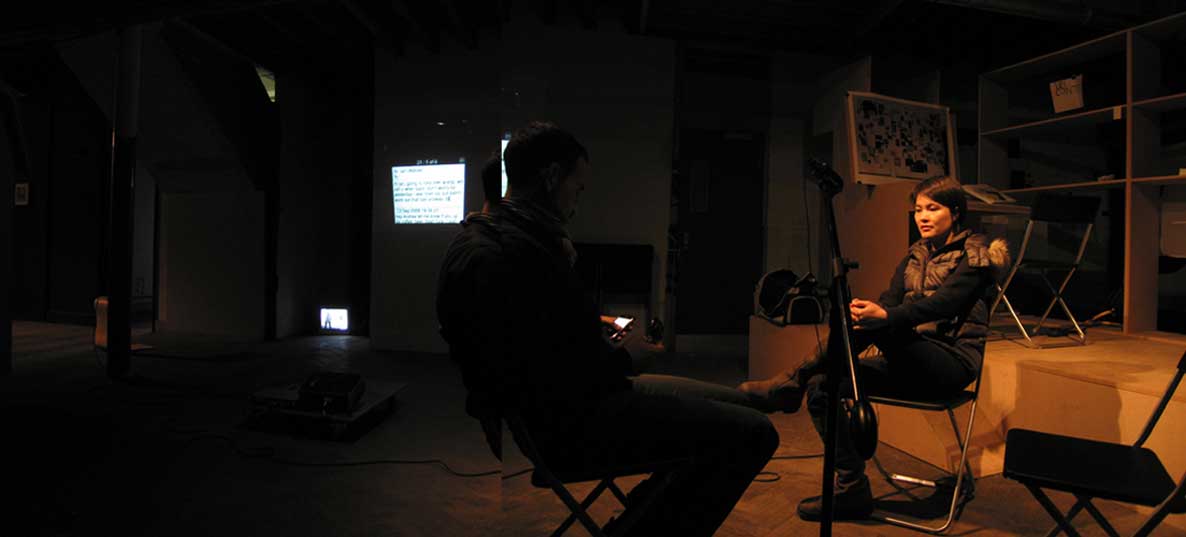
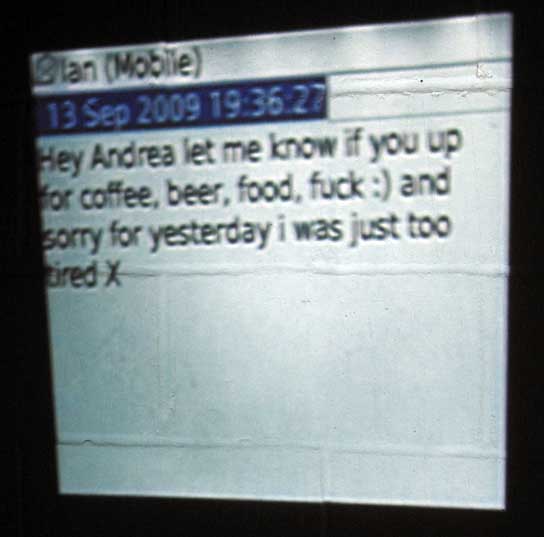


Kate Wiggs & Joanna Austin: Symposium
We propose a performance that takes the form of a two way conversation around the subject of the role of conversation in our practice, and the affinities between theory and practice in art making. Having the conversation three ways refers to the Classical group debate format, and we will also be making reference to Plato’s original symposiums by fuelling the debate with red wine. Joanna and I are visual artists working in performance, video and installation, and Martin is a writer, curator and lecturer. The fact that we come from slightly different but overlapping fields, are all passionately engaged with what we do, and know each other’s work well, we anticipate that this will be a lively discussion. We will not acknowledge the audience at any time.
We propose a performance that takes the form of a two way conversation around the subject of the role of conversation in our practice, and the affinities between theory and practice in art making. Having the conversation three ways refers to the Classical group debate format, and we will also be making reference to Plato’s original symposiums by fuelling the debate with red wine. Joanna and I are visual artists working in performance, video and installation, and Martin is a writer, curator and lecturer. The fact that we come from slightly different but overlapping fields, are all passionately engaged with what we do, and know each other’s work well, we anticipate that this will be a lively discussion. We will not acknowledge the audience at any time.
Andrea Giulivi & Iyvone Khoo: Four Guys
4 short videos (about 2 minutes each) to be shown on a television set or projected onto a screen. The work examines SMS text messaging exchange between ‘almost strangers’ in the context of a gay relationship.‘Four Guys’ investigates conversations in non-platonic relationships through the personal experiences of Andrea with four gay men through the mobile phone.The videos containing conversations revealing the etiquettes of ‘courtship’, ‘seduction’ and explicit ways of communication between people that barely knew each other.Often these conversations are directed towards a meeting suggesting sexual gratification on the agenda. (The conversations do not carry significant emotional implications, it is direct, precise, personal yet impersonal, carrying with it a sexually charged natured, driven by one’s desire to fulfil one’s physical needs with no strings attach.) We are interested to investigate the dialogues and the dynamics in these conversations each revealing different approaches and ways of managing a conversation.How does a conversation start? Where does a conversation lead?H ow does a conversation end?
(An Extract of the conversation)
Chris: Hey, we met at the opening last Wens, wanna meet for coffee in Soho? Chris x
Andrea: Oh Hello…I am free from 4pm Wens in that part of town
Chris: Let’s meet for coffee in Soho, I live in Soho, come and we can fuck all night!
Andrea: lets meet for a bite and see J Preferred Time: 2-3pm
Duration: 10-15 minutes video piece
4 short videos (about 2 minutes each) to be shown on a television set or projected onto a screen. The work examines SMS text messaging exchange between ‘almost strangers’ in the context of a gay relationship.‘Four Guys’ investigates conversations in non-platonic relationships through the personal experiences of Andrea with four gay men through the mobile phone.The videos containing conversations revealing the etiquettes of ‘courtship’, ‘seduction’ and explicit ways of communication between people that barely knew each other.Often these conversations are directed towards a meeting suggesting sexual gratification on the agenda. (The conversations do not carry significant emotional implications, it is direct, precise, personal yet impersonal, carrying with it a sexually charged natured, driven by one’s desire to fulfil one’s physical needs with no strings attach.) We are interested to investigate the dialogues and the dynamics in these conversations each revealing different approaches and ways of managing a conversation.How does a conversation start? Where does a conversation lead?H ow does a conversation end?
(An Extract of the conversation)
Chris: Hey, we met at the opening last Wens, wanna meet for coffee in Soho? Chris x
Andrea: Oh Hello…I am free from 4pm Wens in that part of town
Chris: Let’s meet for coffee in Soho, I live in Soho, come and we can fuck all night!
Andrea: lets meet for a bite and see J Preferred Time: 2-3pm
Duration: 10-15 minutes video piece
Cushla Donaldson: Poolside
I think what I will do to build the swimming pool character, is to make one of my stop frame animations like a documentary “the making of” the swimming pool over 24hrs. I would install the miniature pool/ birdbath in the space, perhaps on top of the monitor I screen the animation on, then to illustrate its use, I make a script formed of screen poolside fights and conversations and read it poolside with another performer.
I think what I will do to build the swimming pool character, is to make one of my stop frame animations like a documentary “the making of” the swimming pool over 24hrs. I would install the miniature pool/ birdbath in the space, perhaps on top of the monitor I screen the animation on, then to illustrate its use, I make a script formed of screen poolside fights and conversations and read it poolside with another performer.
Melissa Bliss Things We Get Confused
A conversation between an invited group of people about the things we each get confused: Birds like crows, rook and magpies, places like Peebles, Dalkeith and Penicuik or people like Richard Long and Richard Wilson. Each of us will fess up to a gap in our knowledge, a continual failure of memory, and between us we will work out what we know about each of those things. We will also have a fact checker armed with an iPhone to look things up on the internet – but we can choose to take their advice or ignore. Everything we are confused by will be written up on the table together with what we work out together. I will invite an interesting group of people, chosen for their range of interests and their ability to admit to failure and being wrong.
A conversation between an invited group of people about the things we each get confused: Birds like crows, rook and magpies, places like Peebles, Dalkeith and Penicuik or people like Richard Long and Richard Wilson. Each of us will fess up to a gap in our knowledge, a continual failure of memory, and between us we will work out what we know about each of those things. We will also have a fact checker armed with an iPhone to look things up on the internet – but we can choose to take their advice or ignore. Everything we are confused by will be written up on the table together with what we work out together. I will invite an interesting group of people, chosen for their range of interests and their ability to admit to failure and being wrong.